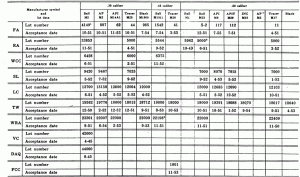The following table was derived from US Army Ordnance Corps documentation. This table lists the first known lots of noncorrosively primed ammunition for .30-06, .45 ACP, and .50 Browning Machinegun (BMG) ammunition from the various US military arsenals. All earlier lots can be assumed to be corrosively primed. (If in doubt, be sure to test each lot of ammunition and take appropriate cleaning precautions.)
Introductory Notes:
Note 1: All earlier ammunition types such as .45 Colt, .38 Colt, .45-70 and .30-40 Krag can all assumed to be corrosively primed.
Note 2: All US military arsenal produced .50 Caliber spotter-tracer, .30 US Carbine, 7.62mm NATO, 5.56mm NATO ammunition has exclusively used noncorrosive primers
Note 3: All post-World War II .38 Special and 9mm Parabellum pistol ammunition from US military arsenals has used noncorrosive primers. Definitive priming data for WWII-era .38 and 9mm ammunition is not available.
Note 4: All tracer and incendiary ammunition should be assumed to leave residue in bores that is hygroscopic and hence have a corrosive effect
Table: Styphnate Primed (Noncorrosive) Small Arms Ammunition Initial Production Lots
Footnotes:
1.Odd lots produced with noncorrosive (styphnate) primers since 1947
2. Lots 5967-5999 starting in 7-50 have noncorrosive (styphnate) primers
3. Steel cased lots S-22000-22007 have noncorrosive (styphnate) primers
Disclaimer: The foregoing information is provided as a public service. It applies only to ammunition from US military arsenals, and no others. If in doubt about the priming of any particular batch of ammunition, then after firing, thoroughly clean your firearm’s bore, chamber, muzzle/flash hider, and bolt face, repeating the cleaning procedure for three days in a row!
James Wesley, Rawles and SurvivalBlog.com will not be held liable for any damage caused by the use of this public domain information.

